If you’ve noticed that the outer edges of your shoes wear down faster than the rest, you might be dealing with supination—also known as underpronation. Supination happens when your foot rolls outward during walking or running, which can throw off your alignment and put extra pressure on certain parts of your foot.
Over time, this imbalance can lead to a range of issues, including ankle instability, heel pain, shin splints, and even stress fractures. The good news? You don’t necessarily need new shoes—just the right support. Shoe inserts designed for supination can provide better alignment, improve shock absorption, and help reduce discomfort with every step.
In this guide, we’ll cover the top 8 shoe inserts for supination in 2025, explain what features to look for, and offer tips to help you find the best option for your feet. Whether you’re walking, running, or simply on your feet all day, the right insole can make a noticeable difference in comfort and stability.
Table of Contents
- What Is Supination?
- How Shoe Inserts Help Supination
- What to Look For in Shoe Inserts for Supination
- The Best Shoe Inserts for Supination
- Tips for Choosing the Best Shoe Inserts for Supination
- When to See a Podiatrist
- Best Shoe Inserts for Supination FAQs
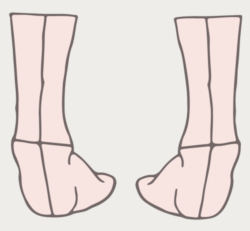
What Is Supination?
Supination—also known as underpronation—is a natural movement of the foot that occurs when your weight rolls to the outer edges during walking or running. A small degree of supination is normal, but excessive supination can throw off your biomechanics and lead to a range of foot and lower-body problems.
Supination vs. Overpronation
To understand supination, it helps to compare it with its more common counterpart: overpronation. Overpronation happens when the foot rolls inward too much, often associated with flat feet. Supination, on the other hand, is when the foot rolls outward excessively, typically linked to high arches. Think of them as opposite ends of the gait spectrum—both can lead to misalignment and discomfort if not addressed.
How to Tell if You’re a Supinator
Here are a few signs you might be supinating:
- Shoe wear pattern: The outer edges of your soles—especially near the heel and forefoot—show more wear than the center or inner side.
- Gait observation: Your foot lands more on the outer edge when you walk or run, and may not roll inward enough for shock absorption.
- Foot type: High arches are commonly associated with supination, though not everyone with high arches will supinate.
- Common symptoms: You may experience ankle instability, heel pain (especially under the outer heel), shin splints, or recurring stress injuries in the lower leg.
Long-Term Risks If Left Uncorrected
While occasional supination might not cause major issues, chronic or severe supination can lead to:
- Plantar fasciitis
- Achilles tendonitis
- Stress fractures (especially in the outer foot or lower leg)
- IT band syndrome
- Hip, knee, or lower back pain due to misalignment
Over time, the lack of proper shock absorption and uneven pressure distribution can take a toll on your joints and soft tissues. That’s why it’s important to recognize the signs early and take steps to support your feet—like using the right insoles designed specifically for supination.

How Shoe Inserts Help Supination
Shoe inserts—also known as insoles or orthotics—can play a major role in correcting the effects of supination. While they won’t change your natural gait entirely, they provide the extra support and cushioning needed to balance out the uneven pressure placed on your feet.
Support Where It Matters
Supinators often lack adequate arch support, which can lead to poor foot alignment and limited shock absorption. A well-designed insole helps stabilize the foot, gently guiding it into a more neutral position with every step. This doesn’t mean forcing your foot to overcorrect—it simply adds structure where your shoes may fall short.
Key Benefits of Insoles for Supination
- Improved Shock Absorption: Supination limits the body’s natural ability to absorb impact, especially during running or prolonged walking. Quality insoles offer extra cushioning under the heel and forefoot, helping to reduce the force traveling up through your legs.
- Better Foot Alignment: By providing support under the arch and heel, insoles help redistribute weight more evenly. This encourages a more efficient stride and helps prevent your foot from rolling too far outward.
- Reduced Pressure on the Outer Foot: Supinators tend to overload the lateral (outer) edge of the foot. Insoles with a slightly cupped heel and contoured footbed help balance out that pressure, which can relieve pain and reduce the risk of overuse injuries.
- Enhanced Comfort and Injury Prevention: With better cushioning and alignment, your feet are less likely to experience common issues like plantar fasciitis, ankle sprains, or stress fractures. Over time, this can mean fewer aches, better stability, and more comfort whether you’re on mile one or mile ten.
In short, the right insole acts like a custom support system—filling in the gaps left by standard shoes and helping your feet move more efficiently and comfortably.
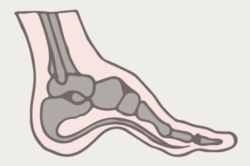
What to Look For in Shoe Inserts for Supination
Not all insoles are created equal—especially when it comes to managing supination. If you’re dealing with underpronation, choosing the right insert means looking beyond basic cushioning. You’ll want a combination of support, stability, and shock absorption tailored to your foot’s needs.
Here are the key features to prioritize:
- Arch Support: Supinators often have high or rigid arches, which can prevent the foot from absorbing impact properly. Look for inserts that offer structured or semi-rigid arch support to help align your foot and improve stability. While the goal isn’t to flatten your arch, a little guidance goes a long way in promoting a more neutral stride.
- Cushioning (Especially Under Heel and Forefoot): Since supinators place more stress on the outer heel and forefoot, those areas need extra padding. Choose insoles with targeted cushioning zones that help soften landings and reduce repetitive stress—especially helpful for runners or anyone on their feet all day.
- Lateral Stability and Heel Cradle: A deep heel cup or cradle helps lock the foot in place and maintain proper alignment throughout the gait cycle. For supination, look for insoles that provide lateral support, minimizing the outward roll of the foot and reducing the risk of ankle instability.
- Materials: Memory Foam, EVA, Gel, and More:
- Memory foam offers plush comfort and molds to your foot.
- EVA foam is lightweight, durable, and great for active use.
- Gel inserts add targeted shock absorption, especially in the heel.
- Composite or dual-layer designs often combine the best of both comfort and structure.
Choose based on your activity level and how firm or soft you want the ride to feel.
Trim-to-Fit vs. Custom Sizing
- Trim-to-fit insoles are more affordable and can be adjusted with scissors to fit your shoe exactly. They’re convenient and widely available.
- Pre-sized or custom orthotics offer a more precise fit and may last longer, especially if you have unique foot dimensions or chronic pain.
Either option can work—as long as the insole aligns well with your arch and shoe shape.
Shoe Compatibility
Make sure the insert fits the types of shoes you wear most:
- Running shoes: Look for lightweight and breathable options that don’t crowd the toe box.
- Casual or dress shoes: Choose thinner, low-profile insoles that won’t alter the shoe’s fit.
- Work boots: Consider durable, shock-absorbing inserts designed for all-day standing or rugged environments.
Always check the thickness, especially if your shoes are snug. A too-thick insole can lead to discomfort or poor fit.
The Best Shoe Inserts for Supination (2025)
Here’s a list of the best shoe inserts for supination (in no particular order):
Spenco RX Orthotic
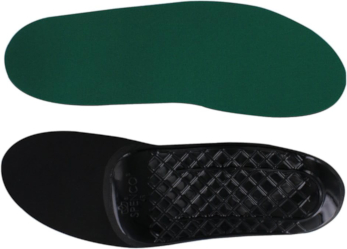
The Spenco RX Orthotic is a full-length insole designed to deliver targeted support, enhanced stability, and superior shock absorption for everyday wear or athletic activity. It features closed-cell nitrogen-injected Spenco cushioning, a proprietary material engineered to disperse impact forces across the entire footbed—helping to reduce pressure points and joint strain during walking or running.
At its core is a moldable, flexible arch support system that conforms to the unique shape of your foot over time, encouraging proper biomechanical alignment and helping to control overpronation or excessive supination. The insole’s lightweight EVA base provides a stable platform that supports medial and lateral foot movement, while the 4-way stretch antimicrobial fabric on top minimizes friction, prevents blisters, and reduces odor.
Finally, a textured grippy surface and contoured heel cup work together to reduce in-shoe slippage, delivering consistent comfort and lockdown throughout long hours of wear.
Shop On AmazonSpenco PolySorb Cross Trainer
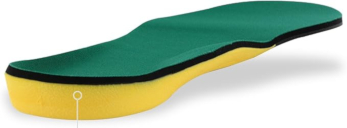
The Spenco PolySorb Cross Trainer insole is designed to deliver multidirectional stability, making it ideal for individuals with supination, where the foot rolls outward during gait. Its semi-rigid arch support and deep heel cup work together to guide the foot into a more neutral alignment, reducing lateral stress on the ankle and minimizing the risk of ankle sprains or strain caused by insufficient inward motion.
Built on a PolySorb polyurethane foam platform, this insole provides resilient structural support while efficiently absorbing and returning energy to promote a smoother, more efficient stride. For those who supinate—often placing excess pressure along the outer edge of the foot—this helps redistribute load more evenly across the foot, improving gait mechanics and reducing fatigue.
At the rearfoot, SpenCore Heel Plug technology delivers high-impact shock absorption, particularly beneficial for heel strikers with supination tendencies who experience concentrated pressure on the outer heel. In the forefoot, the SBR (Styrene Butadiene Rubber) Cushion enhances toe-off propulsion while softening impact during high-intensity or lateral movements, offering a more responsive and cushioned feel under the metatarsals.
A moisture-wicking, low-friction top layer enhances comfort and reduces the risk of blisters, while the insole’s durable construction supports prolonged use without losing its structural integrity. Overall, the Spenco PolySorb Cross Trainer helps compensate for biomechanical imbalances caused by supination—reducing stress on the lateral foot, cushioning high-impact zones, and promoting better alignment to prevent common overuse injuries like IT band syndrome, ankle instability, and peroneal tendon strain.
Shop On AmazonSpenco PolySorb Walker/Runner
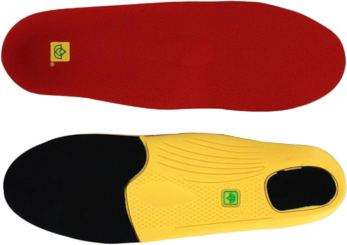
The Spenco PolySorb Walker/Runner insole is purpose-built to enhance biomechanical efficiency and protect against impact-related stress, making it especially beneficial for individuals with supination (underpronation). Supinators tend to place excessive pressure along the outer edge of the foot, particularly at heel strike and toe-off, increasing the risk of ankle instability, stress fractures, and lateral foot pain.
To address this, the insole features a proprietary SpenCore material layer, a closed-cell polyurethane foam engineered to provide long-lasting cushioning and shock dispersion. This material helps evenly distribute impact forces—critical for supinators who often lack adequate natural shock absorption due to limited inward foot roll during gait.
At the heel, SpenCore Heel Plug technology offers targeted high-impact protection where supinators need it most—on the lateral heel. This reduces the jarring forces that can contribute to joint pain in the ankles, knees, and hips, especially during prolonged walking or running sessions.
The insole’s semi-rigid arch support and contoured shape help promote better alignment by gently encouraging a more neutral foot position, which helps correct the outward rolling motion characteristic of supination. This not only improves gait mechanics but also reduces the risk of chronic overuse injuries like peroneal tendonitis and IT band syndrome.
Additionally, the durable construction helps extend the lifespan of footwear by minimizing outsole compression and uneven tread wear—common issues for supinators due to lateral loading patterns. Whether used in training or competition, the Spenco PolySorb Walker/Runner delivers a blend of responsive cushioning, structural support, and biomechanical correction to keep you moving efficiently and comfortably.
Shop On AmazonSuperfeet Premium Berry
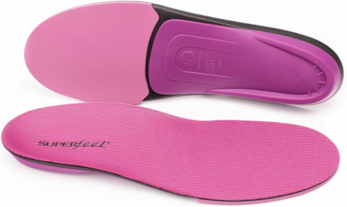
The Superfeet Premium Berry insole is a high-performance insert designed specifically for the anatomical and biomechanical needs of women, offering targeted support and impact protection during high-intensity activities. Its low-profile, full-length design fits seamlessly into most athletic and performance footwear without altering the shoe’s fit, making it ideal for runners, walkers, and cross-trainers alike.
Engineered to address the challenges of supination, this insole features a deep, narrow heel cup that securely cradles the rearfoot and aligns the heel during ground contact. This design helps stabilize the subtalar joint and control the outward rolling motion characteristic of supination, reducing lateral stress on the ankle and minimizing the risk of inversion injuries such as sprains.
The closed-cell high-density foam used throughout the forefoot and midfoot provides responsive cushioning while maintaining its shape under repetitive loading. This is particularly beneficial for supinators, who often experience excessive pressure on the outer edge of the foot—especially during toe-off. By distributing forces more evenly and absorbing shock efficiently, the insole helps prevent fatigue, peroneal tendon strain, and other common issues like lateral foot pain.
At the core of the insole is Superfeet’s patented Encapsulating Stabilizer System (ESS), a structured rearfoot support platform that enhances midfoot stability and improves alignment through the entire gait cycle. For supinators, this promotes a more efficient stride by guiding the foot toward a more neutral path, compensating for the lack of natural pronation.
Shop On AmazonSuperfeet Carbon
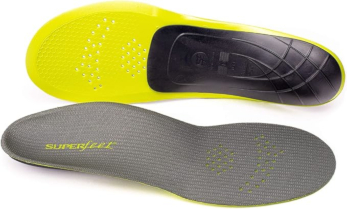
The Superfeet Carbon insole is an ultra-light, high-performance orthotic designed for athletes and active individuals who require precise fit and low-profile support in tight-fitting athletic footwear such as cleats, racing flats, or minimalist trainers. It combines a proprietary carbon fiber-reinforced stabilizer cap with ultralight closed-cell foam, delivering a unique blend of structure, responsiveness, and minimal bulk—perfect for maximizing ground feel and agility without sacrificing protection.
For individuals with supination (underpronation), the Superfeet Carbon addresses key biomechanical vulnerabilities. The rigid carbon fiber stabilizer cap under the heel and arch provides rearfoot control and medial reinforcement, helping to guide the foot into a more neutral alignment and reduce the excessive outward rolling typical of supinators. This stabilizing structure improves subtalar joint positioning, which can prevent lateral ankle instability and reduce strain on the peroneal tendons.
The insole’s deep, structured heel cup enhances natural shock absorption at heel strike—particularly important for supinators, who often land on the outer edge of the heel, concentrating impact forces in a narrow zone. By cradling the heel and redistributing pressure more evenly, the insole helps mitigate heel pain, stress fractures, and lateral foot fatigue.
Additionally, the low-volume, low-profile design reduces shoe fill while maintaining foot alignment, making it ideal for performance footwear where internal space is limited. Despite its lightweight build, the Carbon still offers impact-dampening foam across the forefoot, which improves comfort during propulsion and helps absorb shock during high-impact activity, protecting the lateral forefoot from overloading.
Shop On AmazonSuperfeet Premium Green
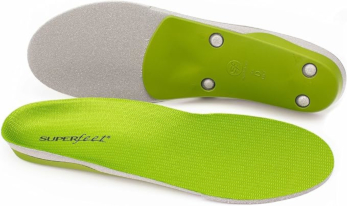
For individuals with supination and high arches, the Superfeet Premium Green insole is a top-tier orthotic solution, widely recognized for its professional-grade biomechanical support and long-standing reputation as one of the brand’s best-selling models. Specifically engineered to address the structural needs of rigid, high-arched feet, it helps correct common alignment issues and mitigates the excessive outward foot roll characteristic of supination.
At the core of the insole is Superfeet’s Encapsulating Stabilizer System (ESS)—a high-density rearfoot support platform that reinforces the heel and midfoot, guiding the foot toward a more neutral gait cycle. This is especially critical for supinators, who typically lack natural shock absorption and are prone to lateral ankle strain, peroneal tendon stress, and increased impact forces on the outer foot. By providing a stable base, the Green insole helps correct foot posture and reduce rotational torque on the lower limbs.
The deep, structured heel cup is one of the most prominent features, designed to securely cradle the calcaneus (heel bone) and align the subtalar joint. This positioning enhances rearfoot stability, improves shock attenuation at heel strike, and helps reduce the risk of common supination-related injuries like stress fractures or lateral knee pain.
Crafted from durable closed-cell high-density foam, the Superfeet Green offers long-lasting, responsive cushioning that retains its shape over time. This foam layer efficiently absorbs and disperses impact forces during running, walking, or high-intensity activity—minimizing stress on joints and soft tissues, especially along the outer edge of the foot where supinators bear the most load.
Available in a range of widths and sizes, the insole also accommodates wider feet without compromising fit or performance. The overall combination of firm arch support, heel stabilization, and targeted cushioning makes the Superfeet Premium Green ideal for managing the biomechanical demands of supination, while promoting comfort, efficiency, and injury prevention during extended use.
Shop On AmazonSuperfeet Premium Orange
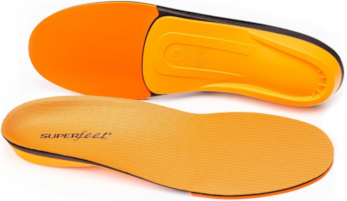
The Superfeet Premium Orange insole is engineered for high-impact, high-intensity activities, making it an ideal choice for individuals with supination (underpronation) who place excessive pressure along the outer edge of the foot during movement. Built on Superfeet’s signature Encapsulating Stabilizer System (ESS), the insole delivers professional-grade support by reinforcing the heel and arch structure—promoting optimal foot alignment and reducing the risk of lateral instability commonly associated with supinated gaits.
A defining feature of the Premium Orange model is its high-rebound forefoot foam pad, strategically placed to cushion and stabilize the forefoot during explosive push-offs, sprinting, or rapid direction changes. This is particularly beneficial for supinators, whose lack of inward roll can lead to inefficient force transfer and excess stress on the lateral forefoot and fifth metatarsal region. The forefoot pad absorbs shock during impact and provides responsive energy return, reducing fatigue and protecting against overuse injuries.
The deep, structured heel cup is anatomically contoured to cradle the rearfoot and align the subtalar joint during heel strike—an essential function for supinators who typically experience harsh impact on the outer heel. This structure aids in dispersing force more evenly across the heel and midfoot, helping to prevent common supination-related issues such as ankle sprains, peroneal tendonitis, and IT band syndrome.
Constructed from durable, closed-cell high-density foam, the insole maintains consistent cushioning and structural integrity even under prolonged load and high repetition. Its multidirectional anatomical shape conforms to the natural contours of the foot, enhancing stability during lateral movements and accommodating the high arch profile often seen in supinated feet.
By combining targeted cushioning, rearfoot stabilization, and dynamic support, the Superfeet Premium Orange is especially well-suited for athletes and active individuals with supination who need maximum shock attenuation and alignment control during demanding training and competition.
Shop On AmazonPowerstep High Insole
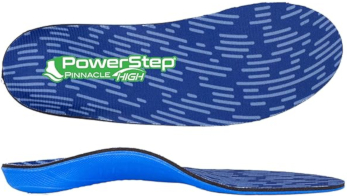
The Powerstep Pinnacle High Insole is specifically engineered to support individuals with high arches and supination (underpronation), offering a combination of enhanced cushioning, structural support, and biomechanical correction. Built with a dual-layer cushioning system, it features a resilient EVA foam base and a plush top layer that work together to provide long-lasting comfort and impact absorption, even during extended periods of standing, walking, or running.
A key component of its design is the integrated metatarsal pad, strategically placed to relieve pressure in the forefoot and redistribute weight away from high-stress lateral zones—a common issue for supinators who push off along the outer edge of the foot. This helps prevent conditions like metatarsalgia or fifth metatarsal strain, which are frequently aggravated by poor pressure distribution.
At the core of the insole is Powerstep’s anatomically contoured arch support, tailored for high arches. Unlike flat or generic inserts, this design provides a precise fit along the medial arch, helping stabilize the foot during the gait cycle. While supination isn’t as commonly associated with overpronation-related injuries, the Powerstep High Insole also features a firm heel cradle and contoured stabilizer shell, which work together to control excessive foot motion in any direction, promoting neutral alignment and reducing undue stress on the ankles, knees, and hips.
The deep heel cup further supports the rearfoot and absorbs shock at heel strike, especially important for supinators who often experience a hard landing on the outer heel. By keeping the heel aligned and supported, the insole helps reduce ankle instability and lateral joint strain during dynamic movement.
Shop On AmazonTips for Choosing the Best Shoe Inserts for Supination
Finding the right shoe insert for supination isn’t just about grabbing the one with the thickest cushioning or highest arch—it’s about choosing an insole that matches your unique foot shape, lifestyle, and footwear. Here are a few practical tips to help you make the best choice:
1. Match to Your Foot Shape and Arch Type
Start by identifying whether you have high arches, neutral arches, or rigid feet. Most supinators tend to have high arches, which means they need structured support rather than overly soft or flat insoles. Look for inserts with moderate to high arch support and a contoured footbed that mirrors your natural shape.
2. Consider Your Main Activity
Think about how you’ll be using the inserts most:
- Running: Go for lightweight insoles with responsive cushioning and breathable materials.
- Walking: Look for balanced comfort and support that helps maintain alignment throughout the stride.
- Standing all day (e.g., work or retail): Prioritize shock absorption and heel support to reduce fatigue.
Your activities should guide your choice of material, cushioning thickness, and overall design.
3. Test Them With Your Main Pair of Shoes
Inserts that feel great in-store might not work well once they’re inside your actual shoes. Always test them in the shoes you wear most, whether they’re running shoes, work boots, or casual sneakers. Make sure there’s enough room—especially in the toe box—and that the insole doesn’t raise your foot too high or create pressure points.
4. Allow for a Break-In Period
Even the best insole might feel a little different at first. Your feet and gait need time to adjust to the new support and alignment. Start by wearing the inserts for a few hours a day, then gradually increase wear time over a week or two. If discomfort persists after this period, the fit or arch height may not be right for you.
By keeping these tips in mind, you can avoid common mistakes and find a shoe insert that genuinely improves your comfort, reduces strain on the outer foot, and supports healthier movement from heel strike to toe-off.
When to See a Podiatrist
While over-the-counter insoles can be incredibly helpful for managing mild to moderate supination, there are times when it’s best to bring in a professional—especially if your symptoms persist despite using supportive footwear.
1. Persistent Pain or Imbalance
If you’re still dealing with chronic heel pain, ankle instability, or discomfort along the outer edge of your foot—even after switching to high-quality shoe inserts—it may be time to consult a podiatrist. Ongoing pain is a sign that something more specific may be going on, such as a structural issue or an underlying condition that requires a personalized treatment plan.
2. Signs Your Current Insoles Aren’t Working
Your insoles should feel like they’re helping, not making things worse. Here are a few red flags:
- Increased discomfort after wearing the inserts
- Blisters or pressure points developing in new areas
- Feeling unstable or off-balance
- No improvement in symptoms after the break-in period
If any of these occur, it’s a strong indicator that your current insoles aren’t the right fit—or that you need something more tailored.
3. Custom Orthotics vs. Over-the-Counter Inserts
- Over-the-counter (OTC) inserts are widely available, more affordable, and suitable for most people with mild supination. They come in various shapes and support levels, and many can be trimmed to fit different shoes.
- Custom orthotics, on the other hand, are specially made based on a podiatrist’s assessment of your gait, foot structure, and medical history. They’re ideal for people with severe supination, recurring injuries, or complex biomechanical issues that can’t be addressed with generic insoles.
While custom orthotics are more expensive, they offer a level of precision and long-term support that off-the-shelf options can’t match.
If your goal is long-term relief and improved alignment—and basic inserts aren’t cutting it—don’t hesitate to schedule a visit with a podiatrist. The right intervention now can prevent more serious issues later on.
Best Shoe Inserts for Supination FAQs
What’s the difference between insoles for supination and overpronation?
Supination (Underpronation) Insoles support feet that roll outward. They offer extra cushioning on the outer heel and forefoot, structured arch support, and lateral stability to reduce ankle strain. Overpronation Insoles support feet that roll inward. They provide firm medial arch support, motion control to prevent arch collapse, and stability to guide the foot back to neutral.
Can insoles fix supination permanently?
No, insoles can’t permanently fix supination, but they can significantly reduce its effects. Supination is often linked to your natural foot structure (like high arches), which can’t be completely changed. However, the right insoles can improve alignment, absorb shock, and prevent injuries, making daily movement more comfortable and stable. Think of them as long-term support—not a permanent cure.
Are custom orthotics better than store-bought inserts?
Custom orthotics are generally better for people with severe supination, chronic pain, or complex foot issues, as they’re made specifically for your feet by a specialist. Store-bought inserts, on the other hand, are more affordable and work well for mild to moderate cases. If you need targeted, long-term correction, custom orthotics offer a personalized solution—but for everyday comfort and support, high-quality over-the-counter insoles often do the job just fine.
How often should I replace my insoles?
Insoles should typically be replaced every 6 to 12 months, depending on how often you use them. If you run regularly, stand all day, or notice signs of wear—like flattened cushioning, bad odor, or decreased support—it’s time for a new pair. High-impact activities may require more frequent replacements, while casual use can stretch their lifespan. Always listen to your feet: if comfort or support fades, it’s a good sign your insoles need an upgrade.
Can I use the same insoles in different shoes?
Yes, you can use the same insoles in different shoes—as long as they fit properly. Make sure the insole doesn’t bunch up, lift your foot too high, or make the shoe feel tight. Trim-to-fit designs are more versatile, while thicker or custom orthotics may only work well in specific shoe types (like running shoes or boots). Swapping insoles between shoes is fine for occasional use, but for best comfort and support, consider separate pairs for different activities.
Final Thoughts on the Best Shoe Inserts for Supination
Dealing with supination doesn’t mean you have to live with discomfort or risk long-term injury. The right shoe insert can make a noticeable difference—improving foot alignment, enhancing cushioning, and relieving pressure on the outer edge of your foot. Whether you’re running, walking, or on your feet all day, the right support can help you move with greater comfort and confidence.
Keep in mind that finding the perfect insole often takes a bit of trial and error. Everyone’s feet are different, so don’t be afraid to test a few options from our top picks to see what works best for your needs. And remember—insoles work best when paired with supportive, well-fitting shoes. Listen to your body, monitor how you feel over time, and don’t hesitate to consult a podiatrist if symptoms persist.
Your feet do a lot for you—give them the support they deserve.
You may also like:
